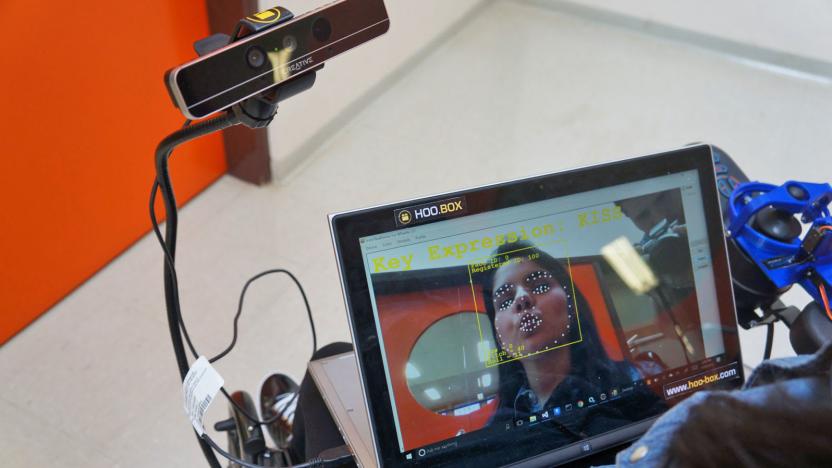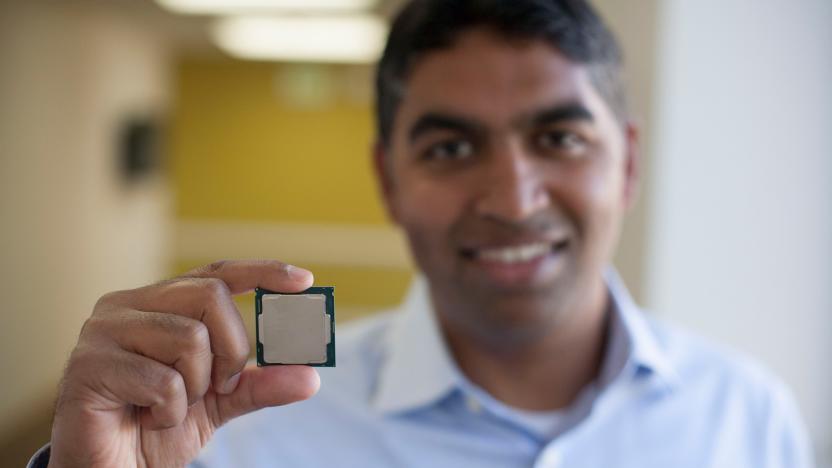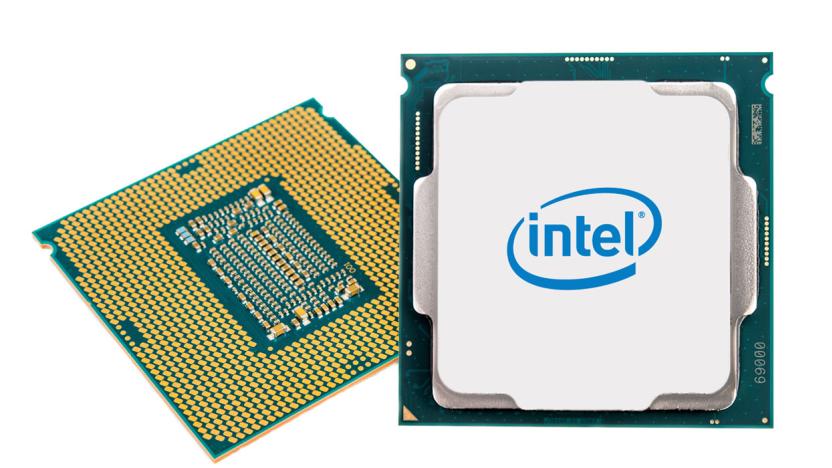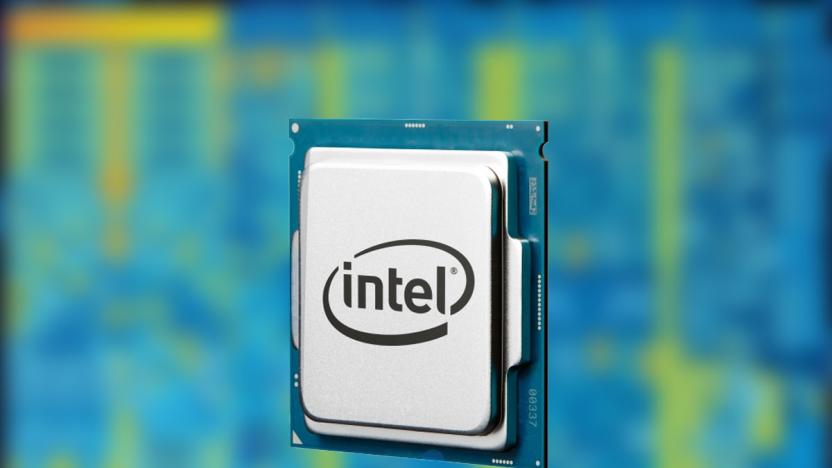Corei5
Latest

Intel announces six new ninth-generation Core processors
Intel's slightly subdued CES 2019 keynote began with the announcement of six new chips for desktop users. The company's Gregory Bryant took to the stage to say that the company was launching a sextet of ninth-generation Core processors. These will range from the low-end Core i3 through to the Core i9 for power users. The company has only revealed details for one of the six chips that will be released, the 14nm Core i5-9400, which it expects to be available at the end of the month.

Behind the quest to control a wheelchair with a smile
Facial recognition software has earned a difficult reputation over the past few years, what with its massive privacy implications and ease of being misused by governments and retailers alike, but the technology has just as many beneficial applications. Take the Wheelie 7, for example.

Intel's 9th-generation Core processors reach up to 5GHz
The rumors were (mostly) true: Intel has unveiled its first 9th-generation Core processors, aiming them at desktop-based enthusiasts. The updated CPUs ultimately represent a refinement of Intel's existing 14-nanometer chips, but promise both more headroom for overclocking (thanks to new soldering), support for Optane-based memory sticks and hardware-level mitigations for Spectre and Meltdown attacks. Naturally, they also boast lots of cores -- not as many as that 28-core Xeon, but you can now expect at least eight cores and the same 18 cores as last year in the flagship Core i9-9980XE model. The Core i9-9900K, meanwhile, is billed as the first "broad volume" processor to hit 5GHz, albeit 'just' when using one of its eight cores (it normally starts at 3.6GHz).

Intel's first 9th-generation Core processors may arrive October 1st
Intel is still struggling to make 10-nanometer chips, but it might still have a few surprises up its 14nm sleeve. WCCFTech claims to have leaked data revealing that Intel will launch its 9th-generation Core desktop processors on October 1st, starting with unlocked models that could make the company's eight-core performance more accessible. The highlight for many would be the Core i9-9900K, the first mainstream desktop Core i9 chip -- you wouldn't have to pay a fortune for an X-series or Extreme Edition CPU. It would tout a 3.6GHz base clock speed, but could boost to 4.7GHz with all eight cores (5GHz with one or two cores) and support up to 16 code threads.

Intel's 8th-gen desktop CPUs boost gaming and streaming speeds
Intel has launched its 8th-generation mainstream desktop chips, calling the flagship $359 Core i7-8700K its "best gaming desktop processor ever." The six-core, 12-thread 3.7GHz chip boosts Gears of War 4 frame rates up to 25 percent compared to 7th-gen desktop chips. It can also do 4K video editing up to 32 percent faster. The best gains are with multitasking, and Intel says gaming, streaming and recording with Player Unknown: Battlegrounds will be 45 percent faster than before.

Spin Samsung's Notebook 7 screen right round on June 26th
When we reviewed Samsung's Notebook 9, my editor Dana noted that it was an excellent back to basics model from the company. It didn't feature a touchscreen or even a rotating screen -- it had a pretty good normal screen, though. For the folks who need the above accoutrements, though, Samsung is introducing the Notebook 7 Spin. With it comes a new 1080p touchscreen you can use like a tablet when spun 360 degrees. Hence the name. The 7 Spin can also go into tent mode for watching a movie with its HDR video capabilities. Or, if you're a traditionalist, you could use the computer like a normal laptop.

Intel's 7th generation of Core CPUs are coming later this year
Besides its $1,723 10-core Core i7 Extreme Edition processor, Intel just teased some other chip news during its keynote presentation at Computex. There aren't many details available, but the company confirmed the the seventh generation of its Core CPU technology will go on sale later this year. They will be joined by its Apollo Lake chips, which are a cheaper version of the current sixth-gen Skylake family. Apollo Lake should bring 4K video capability and USB-C to cheaper, 2-in-1 laptop/tablet style devices with smaller batteries. As far as the seventh generation of Core CPUs, buyers can expect support for Thunderbolt 3, and IR cameras used for features like Windows Hello's facial recognition.

Intel's 'Skylake' CPU family includes an unlocked laptop chip
To say that Intel has been dragging out the launch of its Skylake-based processors would be an understatement when it didn't even reveal full details after it started shipping the first CPUs. Most of that secrecy is coming to an end today, however, as the semiconductor giant is officially launching the wider 6th-generation Core family. You'll soon see mainstream Core i3, i5 and i7 chips in desktops and laptops, as well as updated Core M processors in ultraportables, convertible PCs and tablets. As you'll see in a minute, though, this isn't just a straightforward refresh.

Intel will let you build your own 3D-printed robot later this year
Intel CEO brought a robotic companion named Jimmy with him on stage at Code Conference today. Jimmy is a 3D-printed robot capable of walking, talking, moving his arms, dancing and even tweeting, and it's the key to Intel's vision of the future of robotics. Starting later this year, the company will make an open source robot kit with 3D-printed parts available to consumers for $1,600, with a research version for $16,000. The former will run on Intel Edison, the company's computer-on-a-chip, while the latter will be powered by a Core i5 processor.

Surface Pro 2 tablet gets a quiet speed bump to 1.9GHz
Sometimes, it pays to avoid the bleeding edge of technology. Microsoft has confirmed to The Verge that newer Surface Pro 2 tablets are shipping with a faster 1.9GHz Core i5 inside instead of the 1.6GHz chip that came with the earliest models. The company isn't saying just why it rolled out the stealthy upgrade, although it notes that "routinely" tweaks designs based on part availability and customer value. The move may frustrate early adopters whose two-month-old Windows slates are already behind the times, but it's good news for latecomers who'll get more for their money.

Apple unveils Haswell-based MacBook Pros with Retina display, starting at $1,299 (update: non-Retina 15-inch is gone)
If you've been waiting for the MacBook Pro with Retina display to get a big processor upgrade, today's your lucky day. Apple has just refreshed its high-end portable line with Intel's Haswell chips, delivering Iris graphics and battery life improvements much like those from the recent MacBook Air update. The 13-inch model manages nine hours of battery life, and the 15-inch unit can last for eight hours on a charge. Both computers carry faster PCI Express solid-state drives, Thunderbolt 2 ports and 802.11ac WiFi, while a higher-end 15-inch variant ships with dedicated GeForce GT 750M video. Either new Mac costs less than its predecessor, too. The 13-inch system starts at $1,299 for a model with a dual-core 2.4GHz Core i5, 4GB of RAM and a 128GB SSD; its 15-inch counterpart starts at $1,999 with a quad-core 2GHz Core i7, 8GB of RAM and a 256GB SSD. Both laptops are available today. Update: Apple has quietly axed the non-Retina 15-inch model; you can still buy its 13-inch sibling (unchanged since its early 2013 update) at a lower $999 price.

Apple updates iMac with Haswell chips, available today starting at $1,299
While you would be excused for thinking the iPhone 5s and iPhone 5c were Apple's latest offerings, you'd be wrong. Today, Cupertino has announced that the iMac range has been updated to include new silicon (Haswell) new GPUs and improved WiFi. The entry-level 21.5-inch iMac houses a 2.7GHz quad-core Intel Core i5 with iris Pro graphics, while the top spec version (both sizes) comes with 3.4GHz and NVIDIA GeForce 700 series graphics, plus the option to upgrade to core i7 at 3.5 GHz. That WiFi refresh brings "next gen" 802.11ac, and there's also support for PCIe-based flash storage meaning up to 3TB of Fusion drive, or 1TB SSD. The new models are available today, starting at $1,299 for the 21.5-inch, and $1,799 for the bigger display.

Samsung's 3,200 x 1,800 ATIV Book 9 Plus listed for $1,400, shipping August 20th
Samsung generated some buzz last month with its ATIV Book 9 Plus sporting a res-tacular 13.3-inch, 275 ppi touchscreen, but left people asking "when" and "how much?" Retailer B&H Photo-Video seems to have answered those questions, listing a $1,399 price and expected availability of August 20th (at the source). That sum will get you a 1.6GHz Haswell Core i5-4200U dual-core CPU, 4GB of DDR3 RAM, a 128GB SSD, Intel HD 4400 graphics, Windows 8, and of course, that 3,200 x 1,800 touchscreen. As we noted before, you'll be able grab more RAM, a bigger SSD and a Core i7 processor for the light-ish 1.39kg (3.06 pound) device if you're willing to pay more. Though those options aren't listed yet, they'd likely price you into MacBook Pro Retina territory -- but at least you'd get way more pixels. [Thanks, Jason]

Acer's 23-inch Z3-605 all-in-one ships to the US, starting at $700
Want a straightforward Windows 8 all-in-one that won't cost a pretty penny? Acer has you covered with the launch of its Z3-605 Series in the US. The 23-inch desktop isn't a performance champ when it carries up to a Core i5 CPU, 8GB of RAM, a 1TB hard drive and a DVD burner. Don't dismiss it out of hand, however -- the 1080p IPS-based LCD should deliver a good-looking picture, and a touchscreen variant supports air gestures. If there's enough here to leave you intrigued, you can pick up the Z3-605 today for a modest $700 in base trim, or with touch for $800.

CompuLab MintBox 2 unveiled with four times the power, same Linux Mint flavor
Now that Linux Mint 15 is available, it's only fair that we get a new MintBox to match. The CompuLab and Linux Mint teams won't disappoint us on that front: they've just previewed the MintBox 2, a big upgrade to their open source mini PC. The new version drops AMD processors in favor of an Intel Core i5 that's reportedly four times faster than the AMD T56 in the MintBox Pro. The refresh also doubles the storage to 500GB while adding a second gigabit Ethernet jack for server duties. CompuLab and Linux Mint haven't said how soon they expect the MintBox 2 to ship, but they're expecting a $599 price at Amazon.

Fujitsu intros Lifebook UH90 with Haswell and a 3,200 x 1,800 IGZO touchscreen
Fujitsu burst on to the Ultrabook scene in earnest with the Lifebook UH75 last fall, and it's clearly bent on keeping our attention: it just launched an early sequel, the Lifebook UH90. The 14-inch portable is ever-so-slightly thinner than its ancestor at 15.5mm (0.61 inches) thick, but upgrades to an extra-dense 3,200 x 1,800, IGZO-based touchscreen. The improvements are more than just skin-deep, of course. A Haswell-based, 1.6GHz Core i5 helps feed that monster display, and a 500GB hybrid hard drive strikes a balance between speed and storage. Japanese buyers will get a crack at the UH90 on June 28th under the country's customary open pricing system. There's no word yet on a possible US release, but we hope one is on the cards. In case the UH90 is too pricey, Fujitsu also has a trio of more modest PCs on tap. The Esprimo FH78 all-in-one (shown after the break) runs on a Haswell-era, 2.4GHz Core i7 and stuffs a 30W, 2.1-channel Pioneer speaker system underneath its 23-inch display. The PC builder's 15.6-inch Lifebook AH models have also been given a slight bump: the AH45's battery life has doubled to 6.4 hours, and the AH42 has upgraded to a 2.4GHz Pentium while lasting for 7.9 hours on a charge. We're not expecting the Esprimo to reach the US, although the starter Lifebooks may cross the Pacific.

Intel sets Haswell launch for June 4th, details bold battery life claims
Haswell is hardly a secret at this point: there's been a steady drip-drip of demos and technical leaks since as far back as 2011, and just a month ago we brought you the low-down on its integrated graphics. But today, finally, we have official pricing for a number of variants, a concrete date for availability (this coming Tuesday, June 4th) and, perhaps most importantly, some detailed benchmark claims about what Haswell is capable of -- particularly in its mobile form. Sure, Intel already dominates in MacBooks, Ultrabooks (by definition) and in hybrids like Surface Pro, but the chip maker readily admits that the processors in those portable PCs were just cut-down desktop chips. Haswell is different, having been built from the ground up with Intel's North Cape prototype and other mobile form factors in mind. As a loose-lipped executive recently let slip, we can look forward to a 50 percent increase in battery life in the coming wave of devices, with no loss of performance. Read on and we'll discover how this is possible and what it could mean for the dream of all-day mobile computing.%Gallery-189926%

Fujitsu revamps E-series Lifebooks, gives Ivy Bridge one last hurrah
Intel's Haswell-based processors may be just around the corner, but the suit-and-tie crowd can't always wait to buy new PCs, can it? Fujitsu has those impatient corporate buyers covered with a refresh to its E-series Lifebooks. The 13.3-inch E733, 14-inch E743 and 15.6-inch E753 all keep on trucking with Ivy Bridge, but come in silver and red designs that are more elegant than what we saw last year. Not that they're just skin-deep upgrades, mind you. The more common configurations tout more recent 2.6GHz Core i5 processors and 500GB hybrid hard drives, while each system can scale up to 16GB of RAM and a Core i7 for extra-demanding work. When prices start at $999, the new Lifebooks may be inexpensive enough to make shoppers feel better about their timing -- at least, for a few weeks.

Lenovo IdeaPad Yoga 11S available online, reaches Best Buy on June 23rd
Lenovo teased a potential sweet spot in its convertible laptop line when it revealed the IdeaPad Yoga 11S, blending the portability of the Yoga 11 with the raw performance of the Yoga 13. As of now, we can do more than just imagine how well that balance works: the Yoga 11S is at last available to order. Those who plunk down at least $800 can buy the bendy Windows 8 PC online from either Best Buy or Lenovo, although shoppers will want to think carefully before jumping in with both feet. While both outlets equip their Yogas with 4GB of RAM and a 128GB solid-state drive at that price, Best Buy lists a 1.5GHz Core i5 where Lenovo starts with a more modest 1.4GHz Core i3. No matter which outlet beckons, would-be owners will have to bide their time. Lenovo is quoting a four-week wait for new shipments, and Best Buy will only see the Yoga 11S grace its retail stores on June 23rd.

Intel details 4th-gen Core's HD 5000, Iris and Iris Pro graphics: up to 3X faster, 3-display collage mode
Many already believe that the real highlight of Intel's 4th-generation Core processor lineup would be a giant graphics update. Today, Intel is revealing that they're right -- and, importantly, that there's an equally large shift in naming strategy. Where 3rd-generation Core graphics were divided into two tiers, the new generation is focused on three, two of which are built for performance over efficiency. Ultrabooks with 15W U-series processors will use comparatively ordinary (if still faster) HD 5000 graphics. Thin-and-light laptops with 28W U-series chips get a new tier, Iris, that Intel claims is up to twice as fast in 3D as last year's HD Graphics. Power-hungry parts see even more of a boost: they can carry Iris Pro graphics with embedded DRAM, which should double the 3D speed on H-series mobile chips (47-55W of typical power) and triple it for the R-series (around 65-84W) on the desktop. We also know that M-series laptop and K-series desktop CPUs will have Iris Pro options. The feature set for the graphics trio is slightly more familiar to us, although there are a few tricks up Intel's sleeve. All three can draw DirectX 11.1 and OpenGL 4 visuals, as well as take on OpenCL 1.2 computing and faster media processing. We're almost more interested in the display modes, though. Along with receiving "enhanced" 4K output, the new Core graphics can handle a 3-screen collage mode -- we won't need dedicated video for a large, multi-monitor canvas. Sadly, Intel isn't providing more than incidental details about the processors themselves, although it has already teased that we'll get the full story around the Computex show in early June. %Gallery-187340%







